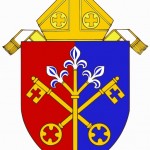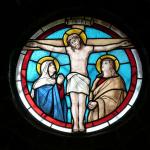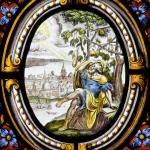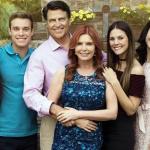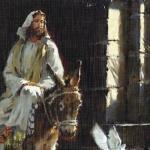 For the celebration of Christmas, the Catholic Church provides separate Scripture lessons and liturgical prayers for four different Masses: the Vigil, Midnight, Dawn, and Daytime. Most of us, though, never hear the readings proclaimed for the Mass at Dawn; we are still tucked warmly in our beds at that hour. That’s an unfortunate loss, because the readings appointed for that Mass are filled with tender grace.
For the celebration of Christmas, the Catholic Church provides separate Scripture lessons and liturgical prayers for four different Masses: the Vigil, Midnight, Dawn, and Daytime. Most of us, though, never hear the readings proclaimed for the Mass at Dawn; we are still tucked warmly in our beds at that hour. That’s an unfortunate loss, because the readings appointed for that Mass are filled with tender grace.
After the presents have been unwrapped and the dinner has been savored, when company has gone and children are tucked into bed, perhaps you’ll find time to read quietly and prayerfully the Gospel for the Mass at Dawn and the second lesson, taken from St. Paul’s letter to Titus.
The Gospel reading is certainly familiar to you. If you haven’t picked up the Bible to read the story for yourself, then you remember Linus’ speech in the Charlie Brown Christmas Special.
When the angels went away from them back into heaven, the shepherds said to one another, “Let’s go to Bethlehem and see this thing that has happened, which the Lord has told us.”
So they hurried off and found Mary and Joseph and saw the baby lying in the manger.
When the shepherds saw them, they told them what the angel had said about the child.
All who heard it were amazed at what the shepherds said. Mary remembered all these things and thought deeply about them.
The shepherds went back, singing praises to God for all they had heard and seen; it had been just as the angel had told them.
–Luke 2:15-20
The second reading is drawn from the brief letter of St. Paul to Titus. Along with St. Timothy, St. Titus was a disciple of St. Paul. He was a gentile Christian who traveled with Paul from Antioch to the Council of Apostles at Jerusalem, and accompanied him on his third missionary journey. Titus was also the bearer of St. Paul’s second letter to the Corinthians. He went on to become the founding Bishop of Crete, where he organized the Church on that island by appointing other bishops and priests.
The first chapter of Paul’s letter to Titus describes the qualities Titus should look for in candidates for the priesthood and for the office of bishop.
During the Mass at Dawn, these words from Paul’s letter to Titus are proclaimed, and they give voice to the heart of the Gospel:
Beloved, when the kindness and generous love of God our savior appeared, he saved us through the bath of rebirth and renewal by the Holy Spirit, whom he richly poured out on us through Jesus Christ our Savior, so that we might be justified by his grace and become heirs in hope of eternal life.
–Titus 3:4-7
As we celebrate the birth of our Savior, we give thanks for the merciful love of God which is our justification and righteousness.
While your Bible is open, though, and while we’re thinking about shepherds, take a look at the first chapter of Titus, which specifically address the attributes of a good bishop:
For since a church leader is in charge of God’s work, he should be without fault. He must not be arrogant or quick tempered, or a drunkard or violent or greedy for money. He must be hospitable and love what is good. He must be self-controlled, upright, holy, and disciplined. He must hold firmly to the message which can be trusted and which agrees with the doctrine. In this way he will be able to encourage others with the true teaching and also to show the error of those who are opposed to it.
For there are many, especially the converts from Judaism, who rebel and deceive others with their nonsense. It is necessary to stop their talk, because they are upsetting whole families by teaching what they should not, and all for the shameful purpose of making money.
–Titus 1:7-11
The challenge remains for today’s bishops, who must first personally exhibit those qualities of holiness and self-control and, most especially, fidelity to Church teaching. Then, they must confront error whenever possible, leading their flock back to the truth by their words and their example.
In recent weeks and months, we’ve seen several examples of strong episcopal leadership. For example:
- Paramount in people’s minds is Bishop Thomas Olmsted’s clear stance in revoking the “Catholic” status of a Phoenix hospital which persists in defending abortion.
- Earlier this year, Archbishop John Nienstedt (St. Paul-Minneapolis) denied communion to members of the Rainbow Sash Movement, which publicly advocates for same-sex marriage, at a student mass at St. John’s University.
- When legislators in Maine approved gay marriage, it was Bishop Richard Malone (Portland in Maine) who led the citizens campaign to bring the issue before Maine voters—a campaign which resulted in repeal of the legislation in November 2009.
- And Cardinal Francis George, president of the US Conference of Catholic Bishops, issued a strong statement opposing Notre Dame University’s conferral of an honorary degree on pro-abortion President Barack Obama.
- Sixty-two bishops joined in opposition to Notre Dame’s invitation to the President to speak at its commencement exercises, and its conferral of an honorary degree.
Despite the criticisms of some in the media and of some within the Church, our bishops have found their voice—and they continue to challenge the culture on many fronts. They are often the face of the Church in the world. For their strong leadership and for their continued defense of the faith, let us give thanks; and let us remember always to pray for them.








